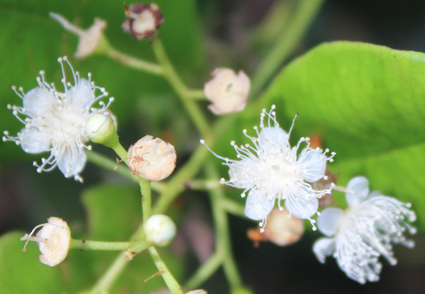Abstract
Our recent studies revealed that the species being grown throughout India as ‘Allspice’ is not Pimenta dioica but an allied species, P. racemosa or Bay rum tree. We could locate true allspice (P. dioica), only at a single location in southern India. P. racemosa can be distinguished by its five lobed calyx and corolla and slightly larger fruits with 3–6 seeds in place of four lobed calyx and corolla and smaller fruits with 1–2 seeds in P. dioica. To elucidate its identity and to avoid the trade of a commodity under an erroneous name, the morphological, anatomical and molecular characters delineating the two species are studied and the distribution of the genus Pimenta in India is discussed here.
References
- Ames, G.R., Barrow, N., Borton, C., Casey, T.E., Matthews, W.S. & Nabney, J. (1971) Bay oil distillation in Dominica. Tropical Science 13 (1): 13–25.
- Bailey, L H. (1968) Manual of cultivated Plants. Vol. 3. The MacMillan Company, New York.
- Bailey, L.H. &Bailey, E.Z. (1976) Hortus. 3rd edn. Macmillan General Reference, New York.
- Bridson, D.M. & Forman, L. (1998) The herbarium handbook. 2nd Ed. Royal Botanic Garden Kew, England.
- Brummitt, R.K. & Powell, C.E. (1992) Authors of Plant Names: A list of authors of scientific names of plants, with recommended standard forms of their names, including abbreviations. Royal Botanic Gardens, Kew.
- Chapman, C.P. (1964) Some aspects of dioecism in pimento (allspice). Annals of Botany 28 (3): 451–458. https://doi.org/10.1093/oxfordjournals.aob.a083905
- Chapman, C.P. (1965) New development in the agronomy of pimento. Caribbean Quarterly 11 (3–4): 3–9. https://doi.org/10.1080/00086495.1965.11828912
- De Vogel, E.F. (1987) Manual of herbarium taxonomy: Theory and Practice. United Nations Educational, Scientific and Cultural Organization.
- Doyle, J.J. & Doyle, J.L. (1987) A Rapid DNA isolation procedure for small quantities of fresh leaf tissue. Phytochemical Bulletin 19: 11–15.
- Flickinger, J. A., Jestrow, B., Oviedo Prieto, R., Santiago‐Valentín, E., Sustache‐Sustache, J., Jiménez‐Rodríguez, F. & Francisco‐Ortega, J. (2020) A phylogenetic survey of Myrtaceae in the Greater Antilles with nomenclatural changes for some endemic species. Taxon 69 (3): 448–480. https://doi.org/10.1002/tax.12263
- Greig, J. (1996) Archaeobotanical and historical records compared—a new look at the taphonomy of edible and other useful plants from the 11th to the 18th centuries A.D. Circaea 12: 211–247.
- Landrum, L.R. (1986) Campomanesia, Pimenta, Blepharocalyx, Legrandia, Acca, Myrrhinium, and Luma (Myrtaceae). Flora Neotropica 45: 1–178. [http://www.jstor.org/stable/4393795]
- Neal, M.C. (1965) In Gardens of Hawai’i. Bernice P. Bishop Museum Special Publication 40. Bishop Museum Press, Honolulu, USA.
- Peguero, B. (2011) Utilidad de las Myrtáceasen la RepublicaDominicana. Moscosoa 17: 115–128.
- POWO. (2023) Plants of the World Online. Available from: https://powo.science.kew.org/ (accessed 10 November 2023)
- Pragadheesh, V.S., Yadav, A., Singh, S.C., Gupta, N. & Chanotiya, C.S. (2013) Leaf essential oil of cultivated Pimenta racemosa (Mill.) JW Moore from North India: Distribution of phenylpropanoids and chiral terpenoids. Medicinal & Aromatic Plants 2 (1): 118–121. https://doi.org/10.4172/2167-0412.1000118
- Purseglove, J.W., Brown, E.G., Green, C.L. & Robbins, S.R.J. (1981) Spices. Vol. I. Longman, London and NewYork. pp. 286–330.
- Riffle, R.L. (1998) The Tropical look. Timber press. Portland.
- Rodriguez, D.W. (1969) Pimento, a short economic history. Commodity Bulletin, Ministry of Agriculture of Jamaica 3.
- Ruzin, S.E. (1999) Plant microtechnique and microscopy. Vol. 198. New York: Oxford University Press. pp. 322.
- Starr, F., Starr, K. & Loope, L. (2003) Pimenta dioica Allspice Myrtaceae. USA: United States Geological Survey—Biological Resources Division. Available from: http://www.hear.org/starr/hiplants/reports/pdf/pimenta_dioica.pdf (accessed 18 June 2024)
- Swetha, V.P., Parvathy, V.A., Sheeja, T.E. & Sasikumar, B. (2014) Isolation and Amplification of Genomic DNA from Barks of Cinnamomum spp. Turkish Journal of Biology 38: 151–155. https://doi.org/10.3906/biy-1308-5
- Thiers, B. (2020) Index herbariorum. New York, New York Botanical Garden. Available from: http://sciweb.nybg.org/science2/IndexHerbariorum.asp (accessed 10 November 2023)
- Turland, N.J., Wiersema, J.H., Barrie, F.R., Greuter, W., Hawksworth, D.L., Herendeen, P.S., Knapp, S., Kusber, W.–H., Li, D.–Z., Marhold, K., May, T.W., McNeill, J., Monro, A.M., Prado, J., Price, M.J. & Smith, G.F. (2018) International Code of Nomenclature for algae, fungi, and plants (Shenzhen Code). Regnum Vegetabile 159. Glashütten: Koeltz Botanical Books. https://doi.org/10.12705/Code.2018
- Zhang, L. & Lokeshwar, B.L. (2012) Medicinal properties of the Jamaican pepper plant Pimentadioica and Allspice. Current drug targets 13 (14): 1900–1906. https://doi.org/10.2174/138945012804545641


